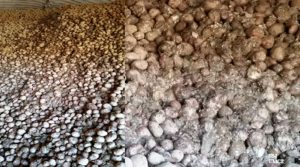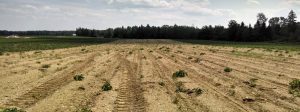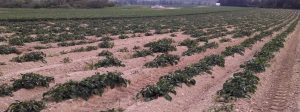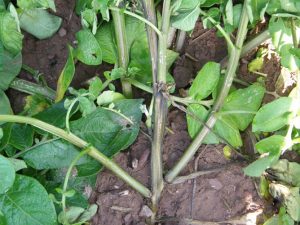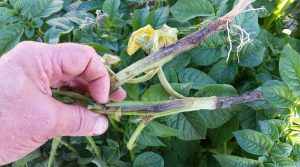Bulletin #2448, Dickeya dianthicola and Pectobacterium parmentieri (Pectobacterium wasabiae) on Potatoes
By Steven B. Johnson, Extension Crops Specialist, University of Maine Cooperative Extension
For information about UMaine Extension programs and resources, visit extension.umaine.edu.
Find more of our publications and books at extension.umaine.edu/publications/.
Dickeya dianthicola and Pectobacterium parmentieri are two of several species of bacteria that cause blackleg disease of potato. Blackleg disease can cause significant economic losses for potato growers.
Dickeya, first reported as a potato pathogen in the Netherlands in the early 1970s, was later reported in Denmark, Finland, France, Hungary, Poland, Slovenia, Spain, and Switzerland. Dickeya spp. (formerly Pectobacterium chrysanthemi, Erwinia chrysanthemi) has emerged as an aggressive potato pathogen worldwide. These bacteria cause wilts and soft rots of many plants, and are responsible for wilting and tuber rot of potato. All potato varieties are susceptible to these pathogens, with some varieties expressing more dramatic symptoms.
- Dickeya dianthicola on potato tubers.
- Dickeya dianthicola field wilt.
- Dickeya dianthicola field wilt.
- Pectobacterium parmentieri storage rot.
Dickeya dianthicola was first identified in Maine during 2014 and has been confirmed in Maine potato seed since then. It is likely that the pathogen was present before 2014, but probably not for as long as it has been present in Europe. The Dickeya situation in Maine follows that of Europe, with field losses confirmed as Dickeya dianthicola continuing to occur.
The taxonomy of the Pectobacterium genus is rapidly evolving. Pectobacterium parmentieri (Pectobacterium wasabiae) has been associated with field and storage losses in Maine. Other members of the Pectobacterium genus are present and continue to cause disease, but not to the catastrophic level of Pectobacterium parmentieri.
As seed-transmitted pathogens, Dickeya dianthicola and Pectobacterium parmentieri can increase during multiplication of seed stocks, particularly where no effort has been made to purge the diseased seed stock. The pathogens can be latent in plant material and may be multiplied while escaping notice. Dickeya dianthicola epidemics are particularly troubling, as they can initiate from very low inoculum levels and spread quickly and aggressively.
- Dickeya dianthicola stand losses.
- Dickeya dianthicola stand losses.
Symptoms
Both Dickeya dianthicola and Pectobacterium parmentierican cause typical blackleg symptoms of dark brown to black stem decay. Disease development is rapid, often affecting the entire plant and resulting in death. Dickeya dianthicola has a tendency to rot from the inside, often showing internal necrosis. Pectobacterium parmentieri, on the other hand, has a tendency to rot the cortical tissue on the outside of stems.
Dense canopies, warm conditions, and long periods of leaf wetness or irrigation favor the development of blackleg. In dry growing conditions, stem rot may not be readily expressed despite the presence of the pathogens.
In a cool growing area like Maine, Dickeya dianthicola symptoms can be underexpressed or even masked. When an infected seed crop from a cool growing area is planted in a warm growing area, the potential exists for nonemergence and stand losses to be expressed dramatically.
Both Dickeya spp. and Pectobacterium spp. can reduce emergence and adversely affect plant health and plant stand. Seed-piece breakdown and nonemergence is a field symptom of Dickeya dianthicola. In cases of delayed emergence, some affected plants can be stunted. Wilting and rapid death can occur shortly after emergence. Under severe Dickeya dianthicola infection, stand losses can be severe.
Infected seed pieces can break down in the field and not emerge, or they can emerge and produce weak, unthrifty plants with wilting foliage. Often, the infected foliage is lighter in color than healthy foliage.
Both pathogens produce pectinolytic enzymes, which are the major cause of rotting potato tubers. Dickeya dianthicola produces creamy, tan to yellow tuber rot that can be granular. The foul odor associated with tuber breakdowns is owing to secondary invaders. Pectobacterium parmentieri has caused storage loss in Maine.
- Dickeya dianthicola stem infection.
- Dickeya dianthicola stem infection.
Disease cycle
Potato seed tubers harboring Dickeya dianthicola or Pectobacterium parmentieri are a confirmed source of these pathogens. At this point, there is no evidence that either of the pathogens overwinter in the soil in Maine. The reported length of survival time in the soil without a host is from 1 week to 6 months, depending on climate. Longer survival is possible on an unharvested infected tuber. The bacteria can survive in surface water or on the roots of some weeds.
The source of the inoculum, and hence the source of the disease, is seed that is internally infected, or seed that is infested with pathogens on the seed surfaces. The disease cycle starts with planting infested or infected seed. Infected seed tubers may have the pathogens present in the stem end of the tuber. More commonly, infested tubers carry pathogens on the surface, particularly in and around the lenticels.
Potato tuber lenticels open under wet soil conditions, thereby providing enhanced infection courts. The spread of these pathogens appears to occur below-ground rather than above-ground. Saturated soil conditions, irrigation, and soil water movement spread these bacteria. Warm conditions favor the development of Dickeya dianthicola and Pectobacterium parmentieri. Dickeya dianthicola can cause potatoes to wilt at any point in the growing season.
Potatoes rotted by Dickeya dianthicola and Pectobacterium parmentieri contaminate harvesting and handling equipment. The infested equipment can transfer the pathogens to a previously uncontaminated lot.
Dickeya dianthicola has been isolated from potatoes in storage, but storage breakdown has not been attributed to this pathogen. However, storage breakdown has been attributed to Pectobacterium parmentieri.
Management
Integrating a disease management strategy throughout the entire potato planting, growing, and harvesting cycle is the key to mitigating losses from Dickeya dianthicola and Pectobacterium parmentieri:
- Identify potential problem lots of potato seed before they are planted.
- Select seed from farms where Dickeya dianthicola or Pectobacterium parmentieri have not been detected, and seed marketed in previous years has not been associated with Dickeya dianthicola or Pectobacterium parmentieri.
- Select seed with zero blackleg levels reported on the North American Certified Seed Potato Health Certificate.
- Avoid seed from fields where symptoms of Dickeya dianthicola or Pectobacterium parmentieri (Pectobacterium wasabiae) have been observed, even if the affected plants were rogued out.
- Avoid bruising and damage during planting and harvest, as well as during the loading of storage bins and shipping trucks, to reduce the risk of disease.
- Avoid harvesting wet fields or tubers with pulp temperatures higher than 65°F, and promote rapid drying of harvested tubers.
Seed growers should consider disinfesting the potato handling equipment between lots. Potato handling equipment is anything that handles the potatoes. Harvesters, windrowers, truck bodies, bin pilers, seed racks, and the like are included.
Tubers harboring Dickeya or Pectobacterium may show no evidence of disease going into storage, and may not decay in storage. However, bacteria on asymptomatic tubers may survive and are likely to cause and spread disease the next year if such tubers are planted.
Reviewed by Associate Professor of Plant Pathology Jay Hao, University of Maine.
Information in this publication is provided purely for educational purposes. No responsibility is assumed for any problems associated with the use of products or services mentioned. No endorsement of products or companies is intended, nor is criticism of unnamed products or companies implied.
© 2018, Reviewed 2020
Call 800.287.0274 (in Maine), or 207.581.3188, for information on publications and program offerings from University of Maine Cooperative Extension, or visit extension.umaine.edu.
The University of Maine is an EEO/AA employer, and does not discriminate on the grounds of race, color, religion, sex, sexual orientation, transgender status, gender expression, national origin, citizenship status, age, disability, genetic information or veteran’s status in employment, education, and all other programs and activities. The following person has been designated to handle inquiries regarding non-discrimination policies: Director of Equal Opportunity, 101 North Stevens Hall, University of Maine, Orono, ME 04469-5754, 207.581.1226, TTY 711 (Maine Relay System).





